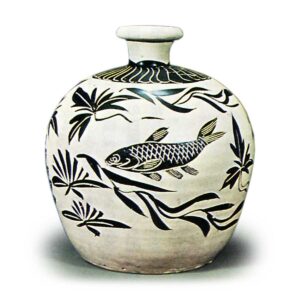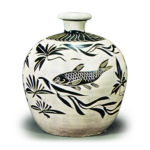
Porcelain has a white, slightly transparent or translucent base, does not absorb water at all, and is harder than ceramics. Most porcelain is glazed. In Japan, pottery was once divided into stoneware and earthenware. Porcelain is the finest of the stoneware types and is the most expensive of all pottery types. Porcelain was created in China. The germ of porcelain was born at the end of the Han Dynasty and developed in the Tang Dynasty, but it was not until the Song and Ming Dynasties that good products were produced. The Jingdezhen kilns in Jiangxi Province are known throughout the world for their exquisiteness and prolific production. In Japan, the porcelain material was discovered and produced by a naturalized Korean, Kanegae Sanbei (Ri Sanpei), in Hizen, Arita, during the Genwa Kanei period (1615-1444), and in Korea, it was probably produced by Chinese potters in the Goryeo Dynasty. In the West, frit porcelain was invented in Spain in the 17th and 8th centuries, feldspar porcelain in Germany, and bone ash porcelain in England, followed by the invention of various types of special porcelain. Hard porcelain is divided into hard and soft porcelain, and hard porcelain includes high-voltage appliances, high-heat appliances, and tableware, while soft porcelain includes oriental porcelain, such as Chinese porcelain, Japanese porcelain, German Segel porcelain, new French sable porcelain, frit porcelain, and bone ash porcelain. The hardness or softness of a porcelain body depends simply on the amount of clay content. When a large amount of clay is present, the firing temperature must be high in order to turn the body into porcelain. These crystals are named sillimanite (Al2O3 SiO2). According to the German Segel’s classification of white porcelain for tableware, (1) hard European porcelain has a clay content of more than 50%, with silica and feldspar in the remainder as appropriate.
(2) Chinese and Japanese porcelains have a clay content of 40% or less, with a larger amount of silica stone than feldspar in the remainder.
(3) New Sevres porcelain from France contains a large amount of clay and a large amount of lime among silica and feldspar. (4) Limoges porcelain from France contains 40% feldspar, a moderate amount of silica, relatively little clay, and a small amount of lime.
(V) Spanish and French frit porcelains contain a large amount of frit and small amounts of lime and clay material. (VI) English bone ash porcelain contains about 50% bone ash, a good amount of clayey matter and feldspar, and a small amount of silica stone. The Zegel porcelain invented by Zegel is similar to oriental porcelain, and contains less than 40% clay, a relatively large amount of feldspar, and an appropriate amount of silica stone. As for hard special porcelains, those for chemical and electrical applications contain more than 60% clay and an appropriate amount of feldspar and silica stone, while those for high-temperature and heat-resistant applications contain a large amount of magnesia and are called talc, talc, and steatite porcelains, which are made mainly from talc. There is also mullite porcelain, which contains a large amount of alumina. The major production centers for porcelain in Japan are Seto and its vicinity, Nagoya, Kyoto, Kutani, Tobe, Tajimi and its vicinity (Mino ware), Arita and its vicinity, Hasami, Izushi, and Hongo. The Chinese character for porcelain is a slang term for “瓷器,” and in the Goza chopping board it is written, “The word for porcelain in the current vernacular is porcelain, and it is most commonly used in the Henan porcelain kilns. In other words, silver is called “Ju-je” and ink is called “Yun-jia”. Thus, the term “瓷器” refers to the solidity of ceramics (陶器, which is the general term for pottery). However, porcelain is not porcelain. In some cases, the term “porcelain” in Chinese texts refers to porcelain ware.








